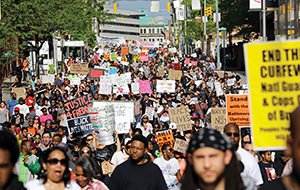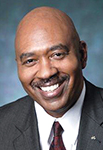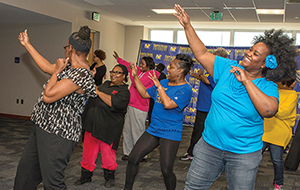By JULIE MINDA
Coalition working to address some of the issues raised in demonstrations
Bon Secours Hospital is just about two miles from an intersection in West Baltimore where protesters took to the streets in April and May in reaction to the death of a black man allegedly catastrophically injured while being arrested and transported by Baltimore city police. (The hospital treated some community members injured in the protests.)
Many commenters lamenting the death of Freddie Gray, 25, have decried the poor socioeconomic conditions that prevail in West Baltimore. For several years, Bon Secours Hospital and its partners in the West Baltimore Primary Care Access Collaborative have been chipping away at some of those socioeconomic issues and at the related health care disparity in West Baltimore. They've been increasing the number of primary care providers, helping community members more effectively access health care, improving coordination among care providers and offering preventive services to help people better their cardiovascular health.
While the challenges are daunting, there is power in numbers. "The greatest benefit (of the coalition's work) has been the opportunity to have 15 institutions aligned in purpose to address health disparities in the West Baltimore community," explained Dr. Samuel Ross, chief executive of Bon Secours Baltimore Health System, which includes the 88-bed Bon Secours Hospital and a network of ambulatory and community services. "Together, we can do so much more for care coordination and address high utilizers (of health care services) that are common to our systems."
Spearheaded by Bon Secours Hospital in 2010 and made up of health systems and hospitals, federally qualified health centers, universities and other partners, the West Baltimore Primary Care Access Collaborative is the subject of an Innovation Forum at the Catholic Health Assembly, June 7-9, in Washington, D.C. Ross and co-presenter Novella Tascoe will describe the collaborative' s approach to increasing primary care access and bettering health outcomes in a session titled "Using Collaboratives and Population Health Strategies to Improve the Health of Communities." Tascoe is the former executive director of community health services for Bon Secours Baltimore Health System.
Countless concerns

Protesters march in Baltimore on May 2, the day after charges were announced against the police officers involved in the death of Freddie Gray, 25, a black man allegedly catastrophically injured while being arrested and transported by police. The West Baltimore community in focus during the protests is an area where Bon Secours Hospital and partner organizations are working to reduce health care disparity.
Image credit: Patrick Semansky/Associated Press
The coalition partners are receiving about $4 million-plus between 2013 and 2017 through a Maryland Department of Health and Mental Hygiene pilot program that targets community health dollars to Health Enterprise Zones, or areas of the state with "measurable and documented economic disadvantage and poor health outcomes."
Four zip codes make up the West Baltimore Health Enterprise Zone, and within that zone are neighborhoods now gaining national attention with the Gray protests. Joy Twesigye directs the West Baltimore Health Enterprise Zone — also known as the West Baltimore Community Access Resources Exchange — for the coalition. "The residents we serve live in the area of the recent protests," said Twesigye.
The West Baltimore Health Enterprise Zone has deep-seated socioeconomic challenges. The zone has "the highest disease burden and worst indicators of social determinants of health" when compared with almost every other community in Maryland, according to information from the coalition.
Compared with the broader city of Baltimore and the state, West Baltimore has the highest percentage of preventable emergency department visits and the worst rates of asthma, diabetes, cardiovascular disease and chronic obstructive pulmonary disease, according to community needs assessments. In some cases, West Baltimore's disease rates are double or triple those of the city and state.
Twesigye said the coalition's programs are meant to address these health care disparities.
Better access to providers
The federal Health Resources and Services Administration has designated West Baltimore as a medically underserved area based largely on its lack of primary care providers and poor health outcomes.
The coalition is using a portion of its Health Enterprise Zone grant to recruit physicians, physician assistants and other primary caregivers, in part by making clinicians aware of state loan repayment and tax credit programs and other incentives to serve in the zone. So far, the coalition partners have attracted more than two dozen primary care providers.
To increase the number of entry-level primary care and other providers, the coalition is offering scholarships of up to $8,000 to West Baltimore community members so they can pursue certificates and other education related to health care jobs.
Chanda Sawyer, 39, is among the 29 West Baltimore residents who have received such scholarships so far. A medical assistant in a pediatrician's office, she used her scholarship to earn a patient care technician certificate that will pave the way for her to apply for a position in a hospital, where there is opportunity for career advancement. In time she wants to study to become a nurse. She said, "This was important for me because this came at a time when I didn't have the money to go back to school."
Out in the community

Ross

Tweisigye
Coalition partners also are using Health Enterprise Zone funds to recruit or hire community health workers. These workers meet with patients of the coalition organizations to help them draw up care coordination plans and to talk through how to overcome challenges to the plan. The community health workers help patients figure out how to get transportation to medical appointments, how to comply with doctors' instructions and how to access social services. The workers also staff health fairs and talk to community members about how to improve their health and how to access local providers effectively. Coalition partners have hired five full-time and one part-time community health workers using their own funds; Bon Secours Hospital employs five additional workers using Health Enterprise Zone dollars.
Patrick O'Neil, one of the community health workers, works with patients in Bon Secours' emergency department. He helps hospital patients understand and follow discharge instructions. "I want to empower these patients so that they know exactly what changes need to be made in their lives in order to achieve optimal health," he said.
O'Neil also helps schedule medical appointments, points patients to help with paying for their utilities and serves as an informal life coach. "The greatest challenge for me is how deeply entrenched some of the issues patients face truly are within this community," he said. "It can be very overwhelming to see what he or she is stacked up against."
Care coordination
Twesigye said West Baltimore's access problem has to do not just with a lack of providers but also with the fact that there had been poor communication — and a poor referral system — among existing providers, as well as a lack of understanding of the primary care system by community members.

Community members line dance at an event showcasing the work of the West Baltimore Primary Care Access Collaborative. Line dancing is an example of the types of fitness programs the collaborative offers. The community event was held March 12, 2014, at Baltimore's Coppin State University, a historically black university.
A by-product of the coalition's work together is that they've learned to communicate better with one another and have built connections, so that they now regularly refer patients to one another. The community health workers play a key role in this care coordination, as they educate community members about the system and help them access coalition providers.
Heart health
With cardiovascular disease a top health concern identified by community needs assessments, the coalition also is using Health Enterprise Zone grant dollars to educate community members about heart health. It does this primarily through the community health workers, who educate consumers at health fairs and point people to heart-healthy services from coalition partners. The educational programming includes free workshops on self-managing chronic disease as well as fitness and nutrition classes and health monitoring.
While the West Baltimore Primary Care Access Collaborative's efforts are a work in progress, and the full impact has yet to be realized and measured, Ross said the coalition's progress can serve as inspiration for other ministry systems and facilities. He advised, "Believe in the possibilities and always be guided by the mission and the needs of the people."
| Partners in the West Baltimore Primary Care Access Collaborative - Bon Secours Baltimore Health System
- Saint Agnes Hospital
- Baltimore Medical System
- Coppin State University
- Equity Matters
- Light Health and Wellness Comprehensive Services, Inc.
- University of Maryland Medical Center, Midtown Campus
- Mosaic Community Services
- National Council on Alcohol and Drug Dependence, Maryland
- Park West Health System, Inc.
- Maryland Senator Verna Jones-Rodwell
- Sinai Hospital of Baltimore
- Total Health Care, Inc.
- University of Maryland Medical Center
- University of Maryland, Baltimore
|
| Bon Secours responds to West Baltimore community During protests surrounding the death of Freddie Gray, 25, community members surfaced concerns about poor socioeconomic conditions around West Baltimore. Bon Secours Health System of Marriottsville, Md., responded by providing funds to bolster existing efforts of Bon Secours Baltimore Health System to address health disparity and social determinants of health in West Baltimore. The regional system is tackling such concerns both through the West Baltimore Primary Care Access Collaborative and through community benefit initiatives. In a message sent to Bon Secours Baltimore, leaders of the parent system's mission fund wrote, "All of Bon Secours stands in solidarity with the Baltimore system and the people of Baltimore during this turbulent time. … While the rioting has calmed, Baltimore is in even greater need of our support to address deep-rooted problems …. The Mission Fund is dedicating $50,000 to the Baltimore Health System to support continuing efforts in the community aimed at addressing the unmet needs of individuals and families."
The message continued, "For years, the Baltimore Health System has been working to improve conditions in the community by developing youth programs, affordable housing, and education. The funds … will go toward increasing activities in many community initiatives, like the Youth Employment and Entrepreneurship, Teen Parent, and Early Head Start programs. We are committed as a mission driven system to improving the conditions that affect the most vulnerable at home and globally."
Bon Secours welcomes additional contributions. Donations can go to: Bon Secours Mission Fund, c/o Ed Gerardo, 1505 Marriottsville Road, Marriottsville, MD 21104; Attention: Baltimore Reconstruction. |
Copyright © 2015 by the Catholic Health Association
of the United States
For reprint permission, contact Betty Crosby or call (314) 253-3477.